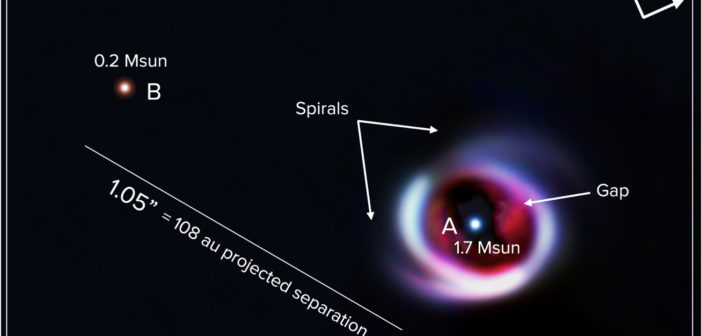Editor’s note: Astrobites is a graduate-student-run organization that digests astrophysical literature for undergraduate students. As part of the partnership between the AAS and astrobites, we occasionally repost astrobites content here at AAS Nova. We hope you enjoy this post from astrobites; the original can be viewed at astrobites.org!
Title: The Orbit of the Companion to HD 100453A: Binary-Driven Spiral Arms in a Protoplanetary Disk
Author: Kevin Wagner, Ruobing Dong, Patrick Sheehan, et al.
First Author’s Institution: Steward Observatory, University of Arizona
Status: Published in ApJ
Today’s paper combines a wide range of data sets — spanning the radio to near-infrared — and analysis techniques — orbit fitting and hydrodynamic simulations — to connect a binary companion to intriguing features seen in the protoplanetary disk around the primary star.
Using the Spectro-Polarimetric High Contrast Exoplanet Research instrument (SPHERE) in 2015, astronomers discovered a two-armed spiral structure in the disk around HD 100453 A (see the cover image). This structure is very different from the gaps seen in images of protoplanetary disks from the Atacama Large Millimeter/submillimeter Array (ALMA) such as HL Tau and TW Hya. The spiral arms seen in the disk around HD 100453 A and two other disks (SAO 206462 and MWC 758) could be caused by a massive companion (planet or star) orbiting outside the disk or processes within the disk such as self-gravity or dead zones. The HD 100453 system is unique in that it has a known M-dwarf companion of about 0.2 solar masses (HD 100453 B). The authors of this paper show that this companion is the cause of the spiral arms seen in the disk, without invoking other driving mechanisms.
The first step in connecting the companion star to the spiral arms of the disk was to determine the companion’s orbit. The authors used six observations with SPHERE and the Nasmyth Adaptive Optics System and Near-Infrared Imager (NACO) cameras on the Very Large Telescope and the Magellan Adaptive Optics system taken over a span of 14 years. The authors took care to minimize systematic errors in the astrometry which could be introduced by errors in the plate scale, orientation of the telescope (which direction is north on the camera) and using a coronagraph. With six pairs of separations and position angles, the authors were able to fit the orbital parameters of the companion M-dwarf. Most important for determining the origin of the spiral arms are the semi-major axis (109 ± 9 au), eccentricity (0.17 ± 0.07), and inclination (32.5 ± 6.5 degrees). This semi-major axis and eccentricity are consistent with the companion truncating the disk at 40 AU, much smaller than a typical disk around a single star.
Since the mutual inclination between the companion and disk has a significant effect on the evolution of the system, the authors needed to determine the inclination of the protoplanetary disk. They used publicly available ALMA observations of carbon monoxide in the disk. Fitting a simple smooth disk profile to the Keplerian orbits of the gas gave a disk inclination of 28 degrees, consistent within 1σ with the inclination of the companion.

Image of the HD 100453 system (top) compared with hydrodynamic and radiative transfer simulation viewed from an inclination of 30 degrees (bottom). [Wagner et al. 2018]
The agreement between the inclination of the M-dwarf companion and the disk suggest that the entire system formed from a single cloud rather than the companion later becoming bound to the primary star (and its disk). The likely inclination of HD 100453 A (determined by comparing the observed rotational velocity of the star with stars of similar mass) is also consistent with the disk and companion star. This rules out a possible scenario where the companion formed separately but torqued the disk to share its inclination while leaving the star untouched.
While the spiral arms in the HD 100453 A disk are clearly driven by HD 100453 B, it is hard to make the same conclusion for the other two disks hosting “grand design” spiral arms. This and other studies suggest where a companion could be located with respect to the spiral arms in those systems, but previous searches for such a companion in these systems have found nothing, setting strict limits on companion mass (or brightness). As always, more work is needed to determine the origin of the spiral arms in SAO 206462 and MWC 758.
About the author, Samuel Factor:
Sam Factor is a 3rd year Ph.D. candidate at The University of Texas at Austin studying direct imaging of extrasolar planets and low mass binary stars. He uses an interferometric post processing technique to allow the detection of companions below the diffraction limit of the telescope.


1 Comment
Pingback: Spiral arms in binary star